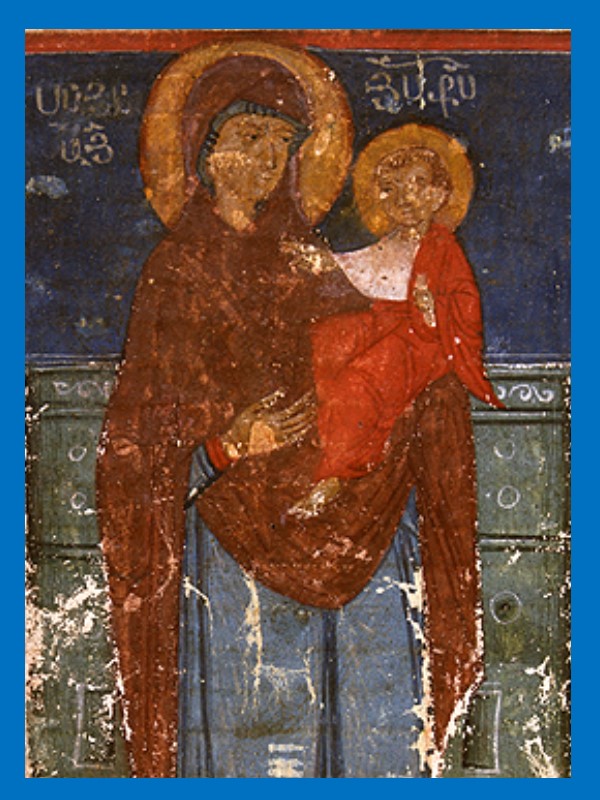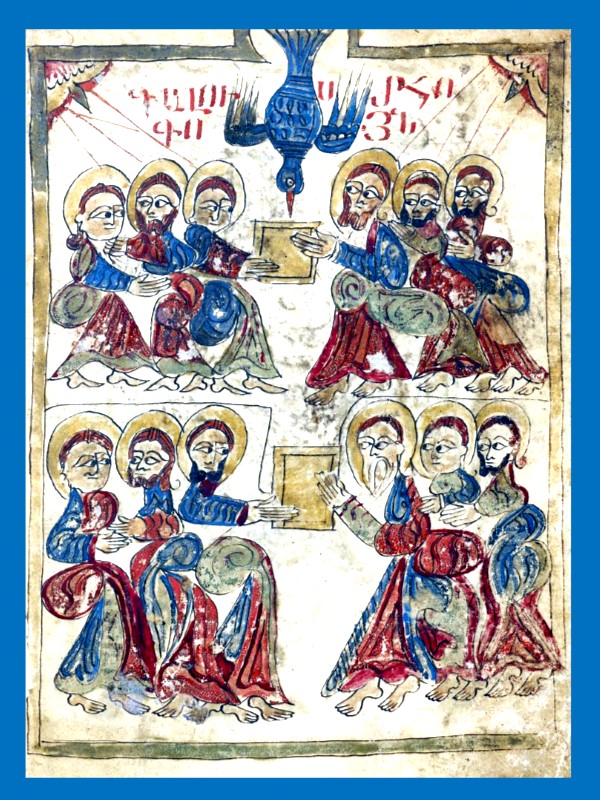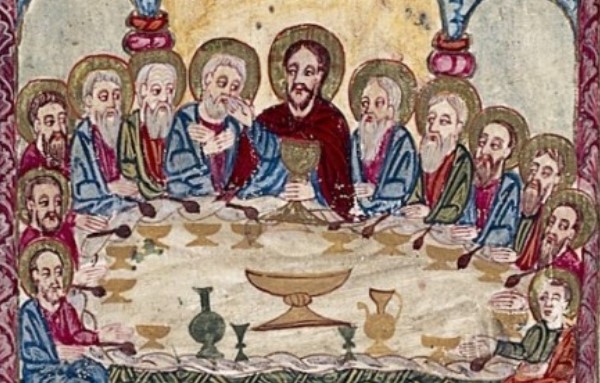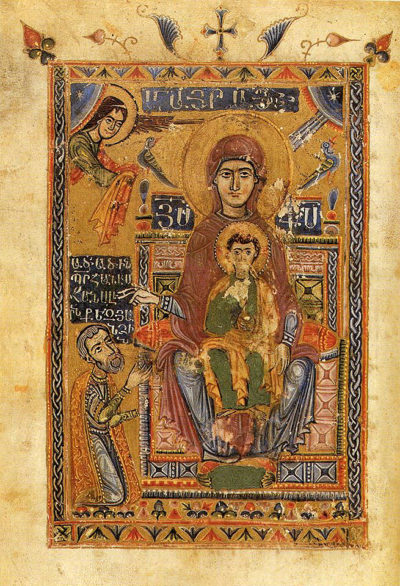WIR BEKENNEN
Katechese –
die Weitergabe des Glaubens
Durch den Glauben wohne Christus in euren Herzen,
in der Liebe verwurzelt und auf sie gegründet.
Eph 3,17
Von Jahrhundert zu Jahrhundert wurde der Glaube der Kirche bis zum heutigen Tag schriftlich und mündlich überliefert. Der gemeinsame Glaube an den Dreieinigen Gott, der uns stärkt, lebendig macht und Hoffnung schenkt, ist die Grundlage unserer Gemeinschaft. Diesen Glauben, der uns durch Christus offenbart und durch die Heiligen Apostel verkündet wurde (Röm 2,18; 1 Kor 14,19; Gal 6,6; Lk 1,4), müssen wir unverfälscht bewahren und an unsere Nachkommen weitergeben. Aus diesem Grund war seit den Anfängen des Christentums eine Vorbereitung vor der Taufe vorgesehen. Dabei wurden den Kandidaten Glaubensgrundsätze vermittelt. Diese Unterweisung nennt man Katechese.
Bei der Vorbereitung auf die eigene Taufe oder die Taufe der Kinder, bei der Übernahme eines Patenamtes oder bei einem bestimmten Lebensabschnitt, – immer hinterfragen wir den eigenen Glauben. Welche Bedeutung hat mein Glaube an Gott für mich? Warum bin oder werde ich armenisch apostolischer Christ? Was ist der Glaube meiner Kirche? Diese und andere Glaubensfragen werden bei der Katechese erörtert.
Auf dieser Seite haben wir einige wichtige Informationen und Tipps für Sie zusammengestellt. Aber auch unsere Geistlichen stehen Ihnen jederzeit gern zur Verfügung, wenn Sie Hilfe benötigen oder Fragen zu Ihrem Glauben haben.
Die Heiligen Mysterien der Kirche
GLAUBENSBEKENNTNISSE DER ARMENISCHEN KIRCHE
Die Armenische Apostolische Kirche verwendet die armenische Übersetzung des Glaubensbekenntnises von Nizäa und Konstantinopel, ein umfangreiches Glaubensbekenntnis vom Heiligen Grigor von Tatew und ein kurzes Taufbekenntnis.
Das Glaubensbekenntnis hat verschiedene Funktionen. Es ist einerseits eine Anerkennung und Ausdruck der Gemeinschaft, die durch den Glauben gegeben ist. Andererseits fasst ein Glaubensbekenntnis die wesentlichen Punkte des Glaubens unserer Kirche zusammen. Wird das Glaubensbekenntnis öffentlich bei einem Gottesdienst vorgelesen, wie z. B. bei einer Priesterweihe, Taufe oder Trauung, so bedeutet es unter anderem auch eine Selbstverpflichtung, nach diesem Glauben zu leben. Insofern ist es wichtig, dass die Armenischen Apostolischen Christen das Glaubensbekenntnis ihrer Kirche auswendig kennen.
Die Armenische Apostolische Kirche verwendet die armenische Übersetzung des Glaubensbekenntnises von Nizäa und Konstantinopel, ein umfangreiches Glaubensbekenntnis vom Heiligen Grigor von Tatew und ein kurzes Taufbekenntnis.
Das Glaubensbekenntnis hat verschiedene Funktionen. Es ist einerseits eine Anerkennung und Ausdruck der Gemeinschaft, die durch den Glauben gegeben ist. Andererseits fasst ein Glaubensbekenntnis die wesentlichen Punkte des Glaubens unserer Kirche zusammen. Wird das Glaubensbekenntnis öffentlich bei einem Gottesdienst vorgelesen, wie z. B. bei einer Priesterweihe, Taufe oder Trauung, so bedeutet es unter anderem auch eine Selbstverpflichtung, nach diesem Glauben zu leben. Insofern ist es wichtig, dass die Armenischen Apostolischen Christen das Glaubensbekenntnis ihrer Kirche auswendig kennen.
Das professio fidei findet während der Taufe in der Armenischen Kirche in einer deklaratorischen Form statt und beginnt nicht mit „Ich glaube“ sondern mit „Wir glauben“. Dies ist mit der Rubrik vor der Abrenuntiatio, der dann gleich die professio fidei folgt, zu erklären, die von einer Säuglingstaufe ausgeht und darauf hinweist, dass der Pate den Täufling in den Schoss nehmen und zusammen mit dem Priester zunächst die Abrenuntiatio und dann den Taufspruch aussprechen soll. Der Text des Taufsymbols lautet:
Wir glauben an die allerheilige Dreifaltigkeit:
an den Vater, den Sohn und den Heiligen Geist,
an die Verkündung Gabriels, die Geburt Christi, die Taufe,
das Leiden, die Kreuzigung, das dreitägige Begräbnis,
die Auferstehung, die göttliche Himmelfahrt, das Sitzen zum Rechten des Vaters,
an die schreckliche und herrliche Wiederkunft,
dies bekennen und glauben wir.
Ein weiteres, ausführliches Glaubensbekenntnis der Armenischen Apostolischen Kirche wurde vom Heiligen Grigor von Tatew (1346-1409) oder von seinen Schülern (im 15. Jh) verfasst. Der Text lautet:
Wir bekennen und wir glauben vollkommenen Herzens an den Vater, Gott, den ungeschaffenen, nicht geborenen und anfangslosen, sondern auch den Hervorbringenden („Gebärer“) des Sohnes und den Hervorströmenden des Heiligen Geistes. (Red. Gott Vater ist der, von dem der Sohn Geboren wird und der Hl. Geist ausgeht).
Wir glauben an das Logos, Gott, den Ungeschaffenen, Geborenen und Beginnenden aus dem Vater vor der Ewigkeit, nicht später und nicht geringer, sondern wie auch immer der Vater – Vater [ist], so [ist] auch mit ihm der Sohn – Sohn.
Wir glauben an den Heiligen Geist, Gott, den Ungeschaffenen, Zeitlosen, Nichtgeborenen, sondern Hervorströmenden aus dem Vater, den mit dem Vater Wesensgleichen und den Mit–Verherrlichten mit dem Sohn.
Wir glauben an die Heilige Dreifaltigkeit: eine Natur, eine Gottheit, nicht drei Götter, sondern einen Gott, einen Wille, ein Königtum, eine Herrschaft, einen Schöpfer der sichtbaren und unsichtbaren [Dinge].
Wir glauben an die Heilige Kirche, an die Vergebung der Sünden durch die Kommunion der Heiligen.
Wir glauben an den Einen aus den drei Personen, an das Wort (Logos), an Gott, der geboren wurde vom Vater vor der Ewigkeit, in der Zeit herabgestiegen in die Gottesgebärerin Jungfrau Maria, von ihrem Geschlecht genommen, und so vereinte er [es] mit seiner Gottheit, neun Monate geduldig getragen im Schoß der makellosen Jungfrau.
Und der vollkommene Gott wurde vollkommener Mensch, mit Seele und Verstand und Leib; eine Person, ein Prosopon (Gesicht), und vereinte Natur. Gott ist Mensch geworden ohne Änderung oder Vermengung, samenlose Empfängnis und unverwesliche Geburt, wonach weder seine Gottheit beginnt, noch sein Menschsein endet, [denn Jesus Christus [ist] derselbe gestern und heute und in Ewigkeit].
Wir glauben an unseren Herrn Jesus Christus, der auf Erden einhergewandelt ist; nach dreißig Jahren zur Taufe kam, [den] der Vater von oben bezeugte: Das ist mein geliebter Sohn, und der Heilige Geist kam in Gestalt einer Taube herab. Er wurde vom Satan versucht, und besiegte ihn. Er hat den Menschen die Erlösung verkündet. Er mühte sich im Leib ab, ermattete, hungerte und dürstete; danach kam er freiwillig zu [seinem] Leiden, wurde gekreuzigt, starb im Leibe und blieb lebendig in seiner Gottheit; der [mit seinem] Leib ins Grab gelegt wurde, vereint mit seiner Gottheit, und mit seiner Seele in die Hölle hinabstieg, in [seiner] untrennbaren Gottheit; der den Seelen predigte, die Hölle vernichtete, und die Seelen befreite, nach drei Tagen auferstand von den Toten und den Jüngern erschien.
Wir glauben an unseren Herrn Jesus Christus, der sich in demselben Leib erhob in den Himmel, und sich zur Rechten des Vaters setzte. Er wird noch kommen in demselben Leib und in der Herrlichkeit des Vaters, um die Lebenden und die Toten zu richten, was auch die Auferstehung aller Menschen [sein wird].
Wir glauben an die Vergeltung der Werke, an das ewige Leben der Gerechten und die ewige Qual der Sünder. Amen.
Die Kirchenväter der gesamten Kirche erarbeiteten beim ersten Ökumenischen Konzil in Nicäa im Jahre 325 ein Glaubensbekenntnis, das mit dem zweiten Ökumenischen Konzil von Konstantinopel im Jahre 381 erweitert wurde. Das Nizäanische Glaubensbekenntnis wird nicht nur von der Armenischen Apostolischen Kirche, sondern auch von der Orthodoxen Kirche bis heute proklamiert. Die Katholische Kirche hat Änderungen im Text vorgenommen, die als “Filioque” bekannt sind und sowohl von der Armenischen Apostolischen Kirche, als auch von den Orthodoxen Kirchen, als Häresie betrachtet wird. D. h. die Textänderungen der Katholischen Kirche, die später von den Evangelischen Kirchen übernommen wurden, stehen im Widerspruch zu den Glaubenssätzen unserer Kirche.
Das Erste Ökumenische Konzil von Nicäa 325, einberufen vom römischen Kaiser Konstantin I., dem Großen, verurteilte die Lehre des alexandrinischen Presbyters Arius (Arianismus), die Jesus Christus dem Wesen nach als zwischen Gott und Mensch stehendes Geschöpf auffasste. Es formulierte die Wesensgleichheit (griechisch homooúsios „wesensgleich“) von Sohn und Vater und verfasste ein erstes Glaubensbekenntnis. Kirchenrechtliche Bestimmungen (Kanones) regelten die Grundstrukturen in der Kirche, so etwa das kanonische Territorium der Lokalkirchen (die späteren Patriarchate) und die Wahl der Bischöfe.
Das Zweite Ökumenische Konzil von Konstantinopel 381, einberufen vom oströmischen Kaiser Theodosius I., verurteilte die Lehre Makedonius I., des Patriarchen von Konstantinopel, und der Pneumatomachen, die die Wesensgleichheit von Gott und dem Heiligen Geist bestritten. Es bestätigte die Gottheit Christi und des Heiligen Geistes und beendete die Abfassung des Glaubensbekenntnisses (des von den orthodoxen und altorientalischen Kirchen seitdem verwendeten Nicäno-Konstantinopolitanums). Der Kirche von Konstantinopel, dem „Neuen Rom“, wurden die gleichen Ehrenrechte wie der Kirche von Rom und der zweite Platz nach Rom eingeräumt. Beide Konzile werden von allen Christen anerkannt.
Hier der Text des Glaubensbekenntnisses, den jeder armenisch-apostolischer Christ auswendig kennen muss:
Wir glauben an den einen Gott,
den allmächtigen Vater,
Schöpfer des Himmels und der Erde, der sichtbaren und unsichtbaren [Dinge].
Und an den einen Herrn, Jesus Christus, den Sohn Gottes,
geboren aus Gott, dem Vater, als Eingeborener, das heißt, vom Wesen des Vaters.
Gott von Gott, Licht vom Licht,
wahrer Gott von wahrem Gott,
Sproß und nicht geschaffen,
von der gleichen Natur des Vaters,
durch den alles wurde im Himmel und auf Erden,
die sichtbaren und die unsichtbaren [Dinge].
Der, indem Er wegen uns Menschen
und um unserer Erlösung willen vom Himmel herabgestiegen ist,
Leib [und] Mensch, geboren auf vollkommene Weise
aus Maria, der heiligen Jungfrau, durch den Heiligen Geist.
Durch Ihn nahm Er den Leib, den Geist und die Seele an
und alles, was des Menschen ist,
wahrhaftig und nicht [nur] dem Anschein nach.
Gelitten, gekreuzigt, begraben,
am dritten Tag auferstanden,
zum Himmel in demselben Leib aufgestiegen,
setzte Er sich zur Rechten des Vaters.
Er wird wiederkommen in demselben Leib,
um in der Herrlichkeit des Vaters
zu richten die Lebenden und die Toten.
Dessen Königsreich kein Ende haben wird!
Wir glauben auch an den Heiligen Geist,
den Ungeschaffenen und Vollkommenen,
der durch das Gesetz und die Propheten und das Evangelium gesprochen hat.
Der in den Jordan hinabgestiegen ist,
verkündete den Gesandten
und wohnte in den Heiligen.
Wir glauben auch an die eine einzige,
katholische und apostolische, heilige Kirche,
an die eine Taufe, an die Buße,
an die Vergebung und den Nachlaß der Sünden,
an die Auferstehung von den Toten,
an das ewige Gericht der Seelen und Leiber,
an das Himmelreich und an das ewige Leben. Amen.












